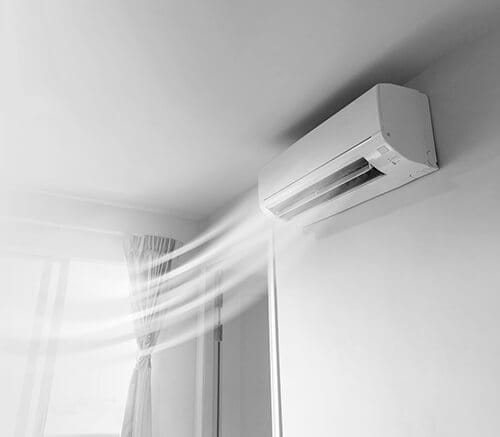November 20, 2023

A Guide to Ductless Mini Split Heat Pumps
Most homes are built with a ducted heating and cooling system. This type of system pushes hot or cold air throughout your home via ducts in the walls or floor from a central heating or cooling unit. If you have an old home that you want to upgrade or if you plan to add another room to your home, then installing a ductless mini split is a far wiser option. Renovation to add a duct to a new addition or to add ducting to an older home is costly and impractical.
But how do ductless systems work? How does this type of system heat and cool your home? And how are they installed?
Heating With a Ductless Mini Split
A ductless system is made up of an outdoor compressor unit and an indoor thermometer unit. The two components are connected by a refrigerant line, a drain line, a suction tube, and a power cord.
A mini split works by transferring heat. When you want to heat a room, the pump draws heat from outdoor sources such as the ground or air into the outdoor unit. The heat is then absorbed into a coil filled with refrigerant. Once extra heat has been added, the refrigerant moves from the outdoor coil to the indoor coil. The heat is released from the coil in the indoor unit to heat the room.
A traditional whole-home heat pump works in the same way but sends the heated air through ducting that runs through the whole house. This type of system is much less efficient because heated air can be lost as it travels through the ducts.
Cooling With a Ductless Mini Split
The air conditioning side of the mini split also works by heat transfer. The outdoor unit comes equipped with a transfer switch which will automatically move to cooling as the outside air grows warmer. The indoor unit will then work to pull heat from the room into the coil inside the unit. The refrigerant in the coil moves to the compressor in the outdoor unit where additional heat is added. Once the heat reaches the outdoor coil, it is dispersed into the air outside.
These heating and cooling processes cycle over and over again to maintain your desired room temperature. Because heat pumps rely on geothermal methods for heating and cooling, they don’t use as much electricity as units that produce their own heat or cold air.
How Is a Ductless Mini Split Installed?
An HVAC professional will start with an inspection of your home and work with you to determine whether to install a single system or a multi-room system.
A multi-room system works well in older homes with outdated heating methods, for large homes, or if your HVAC system is failing. The HVAC contractor can install a central outdoor compressor and then feed lines to different indoor units throughout the house.
Most systems allow anywhere from four to six units. Depending on the size of your house, you can even install one indoor unit on each floor rather than in each room.
After determining the best location for the units, your contractor may need to move furniture to create a work area. He or she will drill a hole into the wall to feed the tubing, lines, and power cord through to the outdoor unit. After connecting the two units, your contractor will mount the indoor thermostat on the wall and test it.
Advantages of Using a Ductless System
It’s More Efficient
A duct system can lose up to 30% of heated or cooled air through gaps in the ducts. You can also lose heated or cooled air in areas that aren’t used a lot, such as attic space. This inefficiency can lead to higher utility bills in the long run. A ductless mini split brings heated or cooled air directly into a frequently used space at a fraction of the cost.
The Units Are Easy to Install
It’s far more complicated and destructive to add ducts to a new addition or to install ducting throughout a home. A contractor might have to rip up flooring or walls, creating a construction zone in your house for at least a few days.
You might be hesitant to have an indoor unit hanging high on your wall, but the thermometer is small and quiet. Your HVAC contractor will only need to drill a three-inch hole to run the power cord and tubing through, which will be covered by the unit itself. A technician can easily install a ductless system in one day.
This Type of Heating and Cooling Is Flexible
Because each indoor unit comes with its own thermostat, they can be set to a comfortable temperature for that area. This can cut down on arguments about thermostat temperature. You can also keep lesser-used areas of the house at lower temperatures to cut down on running costs.
Ductless Mini Splits Can Both Heat and Cool
Ducting systems sometimes require separate systems for heating and cooling. Many homes have a furnace for heat and an air conditioning unit for cooling. A mini split does both in one component, cutting back on the need for extra equipment.
Mini Splits Are Safer Than Window Units
Window units are a popular and less costly way to cool non-ducted rooms, but they can also make it easier for prowlers to get into your home. It also makes an easier entry point for insects or other pests.
Ductless Systems Can Help Alleviate Allergies
In a ducted system, heated or cooled air must move through multiple areas to heat or cool the house. In this air transfer, dust, dander, and pollen often move with the air, increasing the odds of allergen exposure inside. With a ductless system, the heating and cooling are done through lines and tubes, greatly reducing the amount of potential allergens that can get inside your home.
They’re Low Maintenance
Once your mini split heat pump is in place, there’s very little you need to do to maintain it. Cleaning air ducts takes longer and is more complicated than ductless system maintenance. This type of system is less prone to breakdowns or other malfunctions as well.
Disadvantages of Mini Split Ductless Systems
Typically, mini split systems are more costly at the time of installation. This is especially true in the case of a multi-room system. The more indoor units you want to connect to an outdoor unit, the higher the cost of installation.
However, when you factor in the long-term running costs, you’re saving money by not paying to heat less used areas of your home. Further, you can cut costs by creating zones for indoor units rather than trying to put a unit in each room.
Ductless systems also last longer and are more durable than traditional ducted systems. If properly maintained each year by an HVAC professional, your mini split system can last up to thirty years.
Mini Split Systems in the St. Louis Area
A ductless mini split is a more cost-effective way to cool and heat your home, especially in the St. Louis area where winters aren’t too harsh. The benefits of this type of heating and cooling far outweigh any cons and can save you money over time.
If you’re considering this type of system for your St. Louis home, it’s important to hire a professional HVAC contractor to install the system. HVAC professionals are trained to run the lines correctly and position the units for the best possible results.
Here at Scott-Lee Heating Company, we serve the greater St. Louis area. Our technicians are experienced and knowledgeable when it comes to installing ductless systems. With financing options and maintenance agreements, we make it easier than ever to heat and cool your home and keep your system running efficiently. Contact Scott-Lee Heating Company today for more information!
